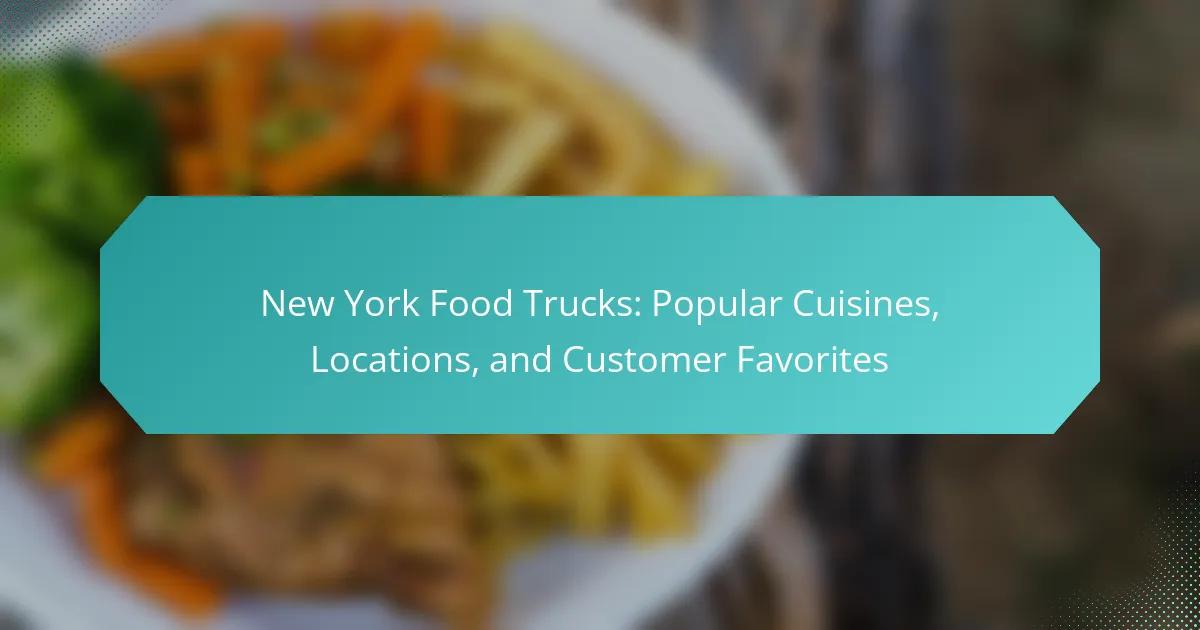New York food trucks are mobile vendors that offer a wide range of cuisines, including Mexican, Asian, Italian, Middle Eastern, and American barbecue. With over 10,000 licensed food vendors in the city, food trucks provide quick, affordable meals at popular locations such as Midtown Manhattan, Bryant Park, and Central Park. The diverse culinary options reflect New York’s multicultural population, with customer favorites including tacos, halal platters, and gourmet grilled cheese sandwiches. Food trucks also adapt their menus to seasonal ingredients and culinary trends, enhancing the vibrant street food culture in the city.

What are New York Food Trucks?
New York food trucks are mobile vendors that serve a variety of cuisines. They operate throughout the city, offering quick and accessible meals. Many food trucks specialize in specific types of food, such as tacos, falafel, or gourmet burgers. The city is home to over 10,000 licensed food vendors, with a significant number being food trucks. These trucks often gather at popular locations like parks, festivals, and busy street corners. They provide a diverse culinary experience reflecting New York’s multicultural population. Food trucks are known for their affordability and convenience. They play a vital role in the city’s vibrant street food scene.
How do New York Food Trucks operate?
New York food trucks operate by obtaining the necessary permits and licenses to sell food on the streets. They typically register with the New York City Department of Health and Mental Hygiene. Food trucks must comply with health regulations, including food safety standards. They also need a mobile food vendor license and a street vendor license.
Once licensed, food trucks choose strategic locations to attract customers. Popular spots include busy streets, parks, and near office buildings. Many food trucks utilize social media to announce their locations and menu offerings. This helps them engage with customers and build a following.
Food trucks often feature a specific cuisine or theme, catering to diverse tastes. They provide a convenient dining option for locals and tourists alike. The vibrant food truck scene in New York City contributes to the city’s culinary diversity.
What types of permits and licenses do they need?
Food trucks in New York need several permits and licenses to operate legally. These include a mobile food vendor license issued by the New York City Department of Health and Mental Hygiene. Additionally, a food service establishment permit is required for selling food. Vendors must also obtain a vehicle license from the New York City Department of Consumer and Worker Protection. A fire department permit is necessary for trucks using cooking equipment. Lastly, a street vendor permit is needed for operating in public spaces. These requirements ensure compliance with health and safety regulations.
How do food trucks source their ingredients?
Food trucks source their ingredients through various channels. Many establish relationships with local farmers and suppliers. This allows them to obtain fresh, seasonal produce. Some food trucks also purchase ingredients from wholesale markets. These markets offer bulk purchasing options. Additionally, food trucks may use online suppliers for specialty items. This approach ensures they can find unique ingredients. Many food trucks prioritize sourcing organic or sustainable products. This trend aligns with consumer demand for healthier options. By sourcing locally, food trucks support their communities.
Why are New York Food Trucks popular among locals and tourists?
New York food trucks are popular among locals and tourists due to their diverse culinary offerings and accessibility. They provide a wide range of cuisines, from classic New York-style hot dogs to gourmet international dishes. This variety caters to different tastes and dietary preferences. Food trucks are strategically located in high-traffic areas, making them convenient for quick meals. Many food trucks also have a strong social media presence, attracting customers through promotions and menu updates. The vibrant atmosphere of food truck gatherings enhances the dining experience. Additionally, food trucks often feature unique recipes and local ingredients, appealing to those seeking authentic flavors. Overall, their combination of convenience, variety, and local charm makes New York food trucks a favorite among many.
What unique experiences do they offer compared to traditional restaurants?
New York food trucks offer unique experiences such as diverse cuisines and mobility. They provide access to gourmet meals in various locations. Customers enjoy the convenience of grabbing food on the go. Food trucks often feature fusion dishes not commonly found in traditional restaurants. They create a casual dining atmosphere that encourages social interaction. Many food trucks have a strong community presence and engage with local events. Some trucks offer limited-time menu items, enhancing exclusivity. The vibrant street food culture adds an exciting element to the dining experience.
How do food trucks contribute to the local economy?
Food trucks significantly contribute to the local economy by creating jobs and generating revenue. They provide employment opportunities for chefs, servers, and support staff. In New York City, food trucks generate approximately $1 billion in annual sales. This revenue supports local suppliers and farmers, promoting regional agriculture. Food trucks also attract tourism, enhancing foot traffic in neighborhoods. Increased foot traffic benefits nearby businesses. The flexibility of food trucks allows them to operate in various locations, maximizing their economic impact. Overall, food trucks stimulate economic growth and community engagement.

What popular cuisines can be found at New York Food Trucks?
New York food trucks offer a diverse range of popular cuisines. Common options include Mexican, offering tacos and burritos. There are also Asian cuisines, featuring dishes like dumplings and ramen. Italian food trucks serve pizza and pasta. Middle Eastern options include falafel and shawarma. Additionally, American barbecue is a popular choice among food truck vendors. Vegan and vegetarian options are increasingly available, catering to diverse dietary preferences. Food trucks often rotate their menus, reflecting seasonal ingredients and culinary trends. This variety contributes to the vibrant food culture in New York City.
Which cuisines are the most frequently served?
The most frequently served cuisines in New York food trucks include Mexican, Chinese, and Middle Eastern. Mexican cuisine often features tacos and burritos, which are popular among customers. Chinese food trucks typically offer dishes like dumplings and fried rice. Middle Eastern options often include falafel and shawarma. According to a 2020 report by the NYC Department of Health, these cuisines consistently rank high in food truck sales. The diversity in offerings caters to a wide range of tastes, making them favorites among locals and tourists alike.
What are the top five cuisines represented on food trucks?
The top five cuisines represented on food trucks are Mexican, American, Asian, Mediterranean, and Italian. Mexican food trucks often serve tacos, burritos, and quesadillas. American food trucks typically offer burgers, hot dogs, and sandwiches. Asian cuisine includes offerings like sushi, dumplings, and rice bowls. Mediterranean options often feature gyros, falafel, and hummus. Italian food trucks frequently serve pizza, pasta, and gelato. These cuisines reflect diverse culinary preferences and are popular among food truck patrons.
How do cultural influences shape the food truck offerings?
Cultural influences significantly shape food truck offerings by determining the types of cuisines available. Food trucks often reflect the diverse backgrounds of their owners. For example, many food trucks in New York feature Latin American, Asian, and Mediterranean dishes. This variety caters to the multicultural population of the city. Additionally, cultural festivals and events can inspire specific menu items. Food trucks frequently adapt traditional recipes to fit the street food format. This adaptation makes cultural dishes more accessible to a wider audience. The popularity of certain cuisines can also drive demand for specific food truck offerings. Overall, cultural influences create a dynamic and evolving food truck scene.
What are some signature dishes from New York Food Trucks?
Signature dishes from New York food trucks include tacos, gourmet burgers, and falafel. Tacos often feature a variety of fillings like carnitas and grilled vegetables. Gourmet burgers are known for their high-quality beef and unique toppings. Falafel is a popular vegetarian option, typically served with tahini sauce. Additionally, food trucks offer dishes like dumplings, lobster rolls, and chicken and rice. These dishes reflect the city’s diverse culinary landscape. Food trucks are a convenient way to experience this variety. They often serve dishes inspired by different cultures and cuisines.
Which dishes have become customer favorites?
Customer favorites among New York food trucks include tacos, gourmet grilled cheese, and falafel. Tacos are popular for their variety and flavor. Gourmet grilled cheese offers a nostalgic yet elevated experience. Falafel is favored for its vegetarian appeal and rich spices. These dishes consistently receive positive reviews and high demand from patrons. Food truck festivals often highlight these items as crowd-pleasers.
How do these dishes reflect the diversity of New York City?
New York City’s food truck dishes exemplify the city’s cultural diversity. These dishes represent various global cuisines, including Mexican, Indian, and Chinese. Each food truck often specializes in a specific cuisine, showcasing authentic flavors and ingredients. For example, tacos from Mexican trucks highlight traditional recipes and cooking methods. Indian food trucks serve dishes like curry and samosas, reflecting the city’s large South Asian community. Chinese food trucks offer dumplings and stir-fries, representing a significant aspect of New York’s culinary landscape. The variety of these dishes indicates the city’s melting pot of cultures and immigrant influences. Food trucks enable chefs to share their heritage through cuisine, making diverse foods accessible to all.

Where can you find New York Food Trucks?
New York food trucks can be found in various popular locations throughout the city. Key areas include Midtown Manhattan, where many food trucks gather during lunch hours. Other hotspots are near parks, like Bryant Park and Central Park, attracting large crowds. The Financial District also hosts several trucks, especially during weekdays. Street fairs and festivals across the city often feature food trucks offering diverse cuisines. Additionally, online platforms and apps provide real-time locations of food trucks. These resources help food lovers find their favorite trucks easily.
What are the best locations for food trucks in New York City?
The best locations for food trucks in New York City include Midtown Manhattan, particularly near Bryant Park and Times Square. These areas attract high foot traffic from tourists and locals alike. Other prime spots are near major subway stations, such as Union Square and Grand Central Terminal. The Financial District also hosts food trucks catering to office workers during lunch hours. Additionally, popular parks like Central Park and Prospect Park provide great settings for food trucks. Events and festivals throughout the city often feature food trucks, increasing their visibility and customer reach. The combination of these locations ensures a steady stream of customers.
How do food truck locations change throughout the week?
Food truck locations vary throughout the week based on demand and events. Many food trucks operate in high-traffic areas during weekdays, such as business districts, to cater to office workers. On weekends, trucks often move to popular parks or event venues to serve larger crowds. Specific events, such as street fairs or festivals, can also influence location changes. Additionally, some food trucks may rotate their locations daily to attract different customer bases. Tracking apps and social media updates help customers locate their favorite trucks. This dynamic approach maximizes sales opportunities and customer engagement.
What are the busiest times for food trucks in popular areas?
The busiest times for food trucks in popular areas are typically during lunch hours and late afternoons. Specifically, lunch hours peak from 11 AM to 2 PM. During this time, office workers and tourists frequent food trucks for quick meals. Late afternoons from 5 PM to 8 PM also see high traffic as people look for dinner options after work. Events and festivals can further increase foot traffic during weekends and evenings. These patterns are supported by sales data from various food truck operators in urban settings.
How can you track the locations of New York Food Trucks?
You can track the locations of New York food trucks using mobile apps and websites. Several platforms provide real-time updates on food truck locations. Popular apps include Food Truck Finder and Roaming Hunger. These apps utilize GPS technology to display food truck routes and schedules. Users can search by cuisine or specific food trucks. Additionally, the NYC Department of Health offers a food truck locator on their website. This resource provides official information about licensed food trucks. Tracking food trucks enhances the dining experience by offering convenience and variety.
What apps and websites provide real-time information on food truck locations?
Popular apps and websites that provide real-time information on food truck locations include Food Truck Finder and Roaming Hunger. Food Truck Finder allows users to track food trucks in real-time based on their location. Roaming Hunger offers a similar service, providing a map of food trucks and their current locations. These platforms aggregate data from various food trucks and update their locations frequently. Users can search by cuisine type and see estimated wait times. Additionally, social media platforms like Twitter and Instagram are often used by food trucks to announce their locations in real-time.
How do social media platforms help food trucks connect with customers?
Social media platforms help food trucks connect with customers by providing real-time updates and engagement opportunities. Food trucks can share their location, menu items, and special promotions instantly. This allows customers to find food trucks nearby and stay informed about their offerings. Platforms like Instagram and Facebook enable visual storytelling, showcasing food items and creating an appealing brand image. Additionally, social media encourages customer interaction through comments and shares, fostering community engagement. According to a survey by the National Restaurant Association, 70% of consumers follow restaurants on social media for updates and deals. This statistic underscores the importance of social media in customer connection for food trucks.

What are customer favorites at New York Food Trucks?
Customer favorites at New York food trucks include tacos, halal platters, and gourmet grilled cheese sandwiches. Tacos are popular for their variety and flavor. Halal platters often feature chicken or lamb over rice with salad. Gourmet grilled cheese sandwiches attract those seeking comfort food with a twist. Food truck festivals often highlight these favorites. According to a 2021 survey, 70% of patrons favored tacos as their top choice. Halal food trucks have seen a 30% increase in popularity over the last five years.
How do customer reviews influence food truck success?
Customer reviews significantly influence food truck success by shaping public perception and driving customer decisions. Positive reviews enhance credibility and attract new customers. According to a survey by BrightLocal, 91% of consumers read online reviews before making a purchase. High ratings can lead to increased foot traffic and sales. Conversely, negative reviews can deter potential patrons and harm a food truck’s reputation. The impact of reviews is amplified on social media platforms, where sharing experiences can reach a wider audience. Therefore, managing customer feedback is crucial for food truck operators aiming for success.
What platforms do customers use to share their experiences?
Customers use social media platforms to share their experiences with food trucks. Popular platforms include Instagram, Facebook, and Twitter. These platforms allow users to post photos, reviews, and comments. Instagram is particularly favored for visual content. Facebook groups often host discussions about food truck experiences. Twitter enables quick updates and interactions. Additionally, Yelp serves as a dedicated review site for food trucks. Customers utilize these platforms to express opinions and recommend their favorites.
How do food trucks respond to customer feedback?
Food trucks respond to customer feedback by actively engaging with patrons through social media and direct communication. They often monitor reviews on platforms like Yelp and Google to gauge customer satisfaction. Many food trucks implement changes based on the feedback received, such as altering menu items or improving service speed. They may also encourage customers to share their thoughts via comment cards or online surveys. This responsiveness helps build customer loyalty and enhances overall dining experiences. By addressing concerns promptly, food trucks can adapt to customer preferences and remain competitive in the market.
What tips can enhance your experience with New York Food Trucks?
Explore various food truck options to discover diverse cuisines. New York food trucks offer a wide range of choices, from tacos to gourmet burgers. Check online reviews and social media for popular trucks and dishes. Many food trucks post their daily locations on platforms like Twitter and Instagram. Arrive early to avoid long lines, especially during peak lunch hours. Bring cash, as some trucks may not accept cards. Be adventurous and try new dishes outside your comfort zone. Consider sharing meals with friends to sample multiple items. Enjoy the outdoor atmosphere and vibrant street life while dining.
How can you find the best food trucks based on personal preferences?
To find the best food trucks based on personal preferences, start by identifying your favorite cuisines. Research popular food truck directories and apps that list trucks by cuisine type. Read customer reviews and ratings to gauge the quality of food and service. Follow food truck social media pages for updates on locations and menu items. Attend local food truck festivals to sample various offerings in one place. Use location-based services to discover nearby trucks. Check for health and safety ratings to ensure quality. These steps will help you find food trucks that align with your tastes and preferences.
What etiquette should you follow when visiting food trucks?
When visiting food trucks, follow these etiquette guidelines. First, wait in line patiently and do not cut ahead. Respect the personal space of others while waiting. Next, have your order ready when you reach the front. This speeds up the process for everyone. Pay attention to the menu and ask questions if needed, but keep it brief. After receiving your food, step aside to allow others to order. Dispose of trash properly to keep the area clean. Lastly, be courteous and thank the staff for their service. These practices enhance the experience for both customers and food truck operators.
New York food trucks are mobile vendors offering a variety of cuisines throughout the city, reflecting its multicultural population. The article explores how these food trucks operate, including the necessary permits and licenses, sourcing of ingredients, and their impact on the local economy. It highlights popular cuisines such as Mexican, Asian, and Mediterranean, along with customer favorites like tacos and gourmet burgers. Additionally, the article discusses strategic locations for food trucks, how to track them, and the importance of customer feedback in enhancing their success. Overall, it provides a comprehensive overview of the vibrant food truck scene in New York City.
